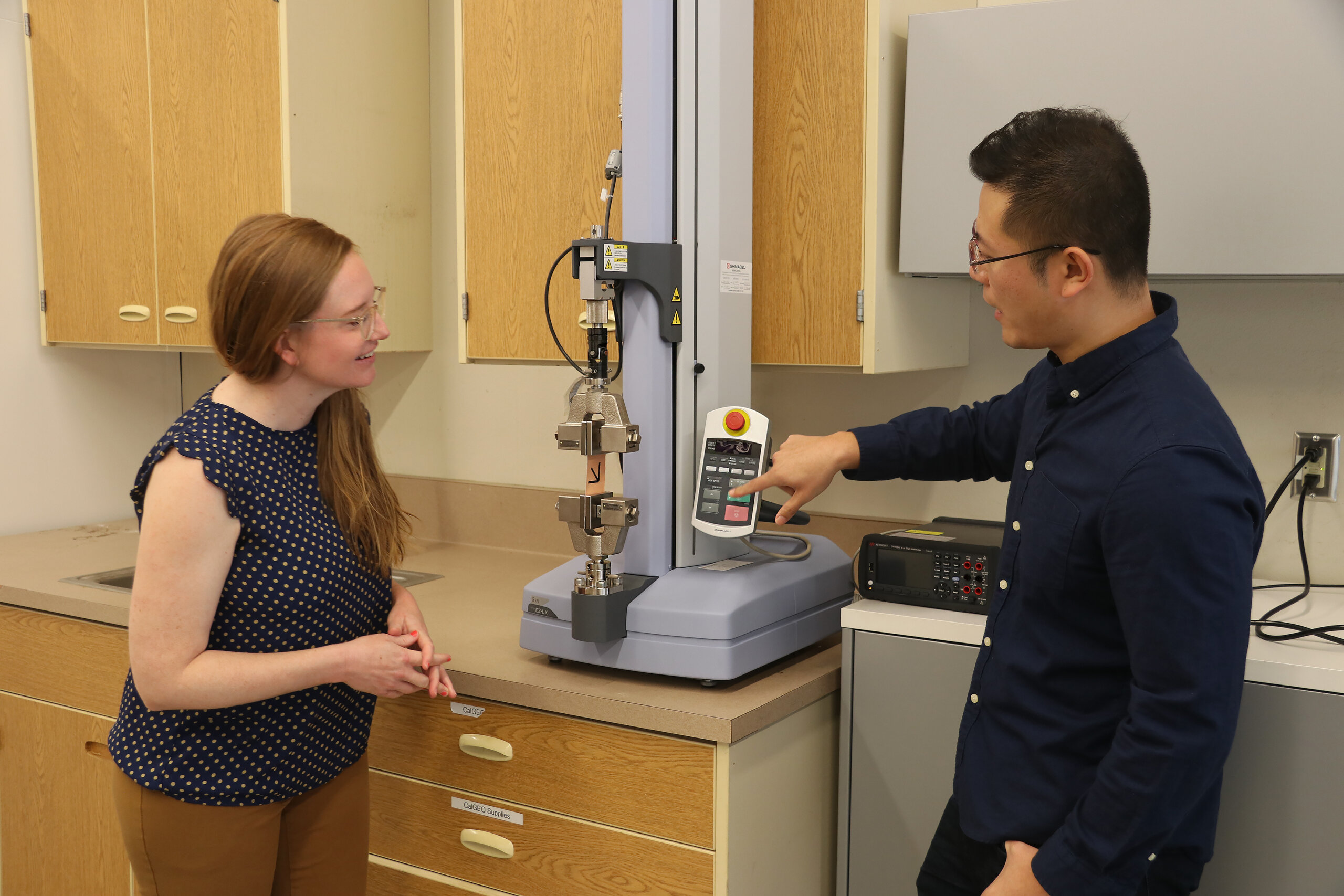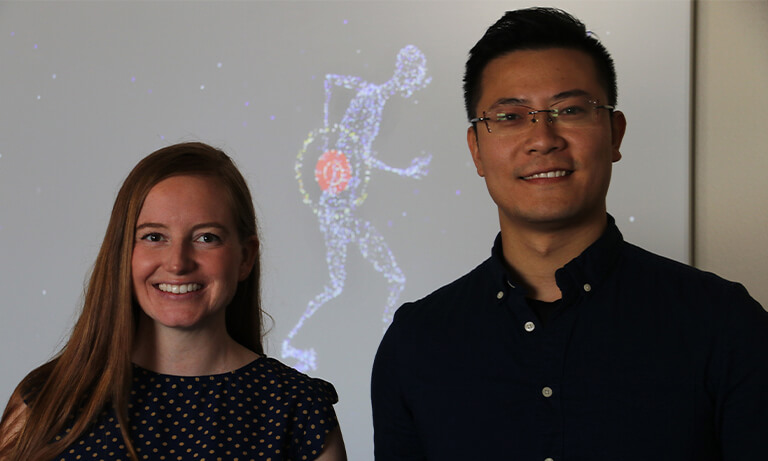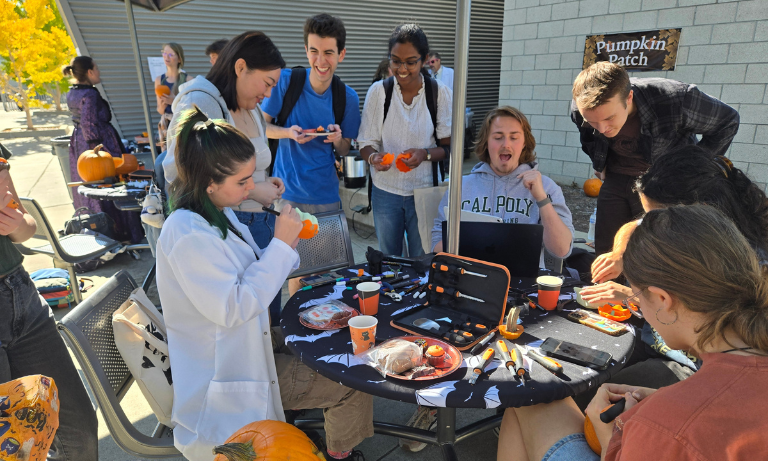Two Cal Poly engineering professors have teamed up on a research project that is eliciting excitement because it addresses the universal human experience of low back pain.
“Everyone can relate to back pain,” said biomedical engineering lecturer Britta Berg-Johansen, who added that up to 80% of the population will face one of the world’s biggest health problems at some point in their lives.
After years spent studying the human spine, Berg-Johansen believes that increasing awareness about the movements that lead to low back pain could be the key to prevention.
Berg-Johansen has teamed up with structural engineering Assistant Professor Long Wang to create a spinal tape that senses bending and twisting, alerting users through an app when they are displaying bad posture or holding a position for too long.
“We want to use sensors to prevent injury on the spine,” Wang explained.
The long strip of athletic tape is attached vertically to the center of the lower back, with tiny sensors made from flexible, sensitive materials affixed to the tape to measure movement.
The pair is now pursuing a patent for their spinal tape with the dream of bringing the invention to the commercial market.
“We are in a back pain epidemic,” said Berg-Johansen, “and this product could help a lot of people.”

Joining Forces
Wang and Berg-Johansen met soon after they both began teaching at Cal Poly in 2020 and formed a dynamic partnership.
“I knew we would make a good team,” Berg-Johansen said.
With her background in spine biomechanics, Wang’s knowledge of nanomaterials and their shared interest in wearable technology, the pair held a brainstorming session and landed on the idea for spinal tape.
They set out to create a flexible device for the lower back to contrast the rigid apparatuses on the market that attach to the upper back to aid those working in desk-based jobs.
The professors were selected to join the CSU Innovation Corps and received guidance in commercializing a medical device, completing a patent search to find out if an invention is new or novel compared to existing technology and identifying consumers.
Initially, the pair pinpointed farmworkers as their target market but after conducting over 50 interviews decided their device could not only help those at high risk for back injury but anyone interested in preventive health care and wearable motion tracking.
“This product will be generalizable for everyone,” Berg-Johansen said.
“We are in a back pain epidemic and this product could help a lot of people.”
Britta Berg-Johansen, biomedical engineering lecturer
Engineering the Device
A biomedical engineering senior project team developed the first prototype of the device during the 2021 academic year. The following year, a master’s student worked on the second prototype, connecting circuitry and creating a system that collected data.
Last summer, a $30,000 grant from the Department of Health and Human Services funded a group of biomedical, computer, materials and mechanical engineering students to create the third prototype.
“I love working on such an interdisciplinary team,” Berg-Johansen said. “It’s a really fun project and there’s never a dull day.”
Computer engineering student Aaron Rosen, who is from Los Osos, joined the team last summer after Berg-Johansen enlisted him to code and design a new circuit board for the device.
Earlier prototypes were bulky and couldn’t easily be worn, so Rosen redesigned the electrical components to be much smaller and thinner, such that they can be attached to the spine tape or a belt clip.
The challenge, Rosen said, was getting consistent readings from the device.
Progress is measured in the Human Motion Biomechanics Laboratory where participants wear the spinal tape while twisting, bending and stretching. Both the tape and cameras that line the room record motion data, which then is compared to the tape’s sensors for accuracy.
“The goal is that data from the cameras and the tape line up,” Berg-Johansen said.
As Rosen adjusted coding for the sensors, Wang experimented with different formulations of nanomaterials in his lab to increase the sensitivity of the spinal tape.
Next Steps
Team members over the academic year took improvements they made on the third prototype to apply to a fourth model, which could be the final iteration.
“We are getting closer on the technology side,” said Berg-Johansen, who was seeking out more grant funding and an industrial partnership.
They will design the aesthetics of the device, decide if users will need a tool to attach the tape on their own and develop the app. They also must consider how to detach the electrical component for reuse upon disposal of the tape after a day of wearing.
“I speculate a lot of people would use this,” said Rosen, who envisions his future self wearing the device while gardening to ensure good posture.
Overcoming Barriers While interviewing dozens of farmworkers and farm managers, Berg-Johansen and Wang learned that undocumented workers may be afraid to report back pain or injury for fear of immigration action or being taken off the workforce. One idea that came out of the CSU Innovation Corps program was that the spinal tape could be marketed toward the fitness and wearable technology industries on the premise that a device would be donated to a farmworker for every purchase made. There also could be potential for a collaboration with the Public Health Department, according to Berg-Johansen.
By Emily Slater


